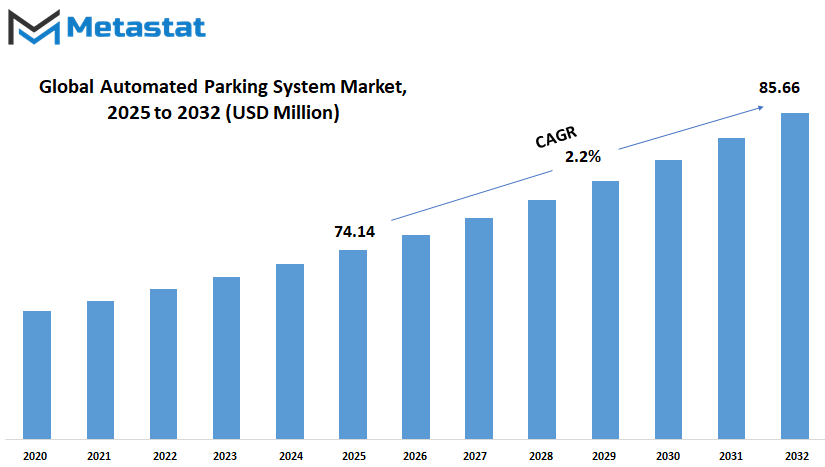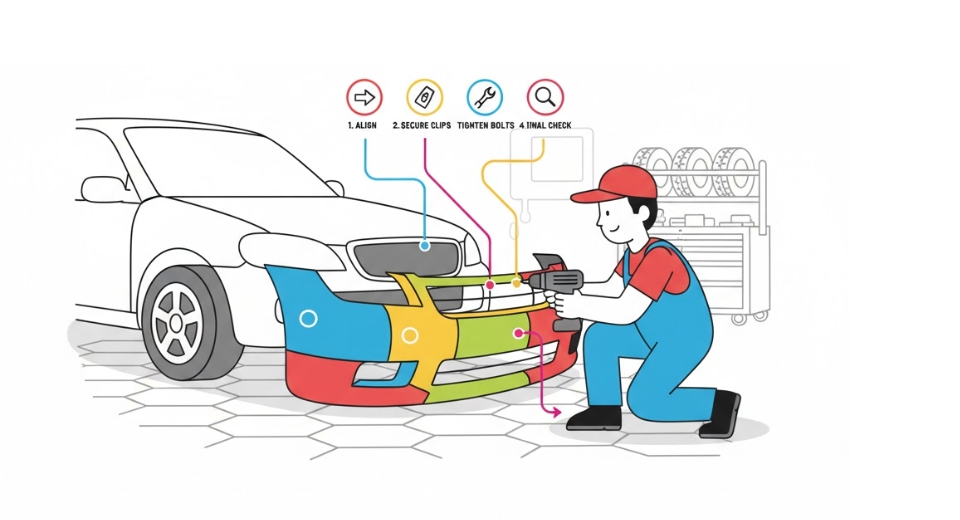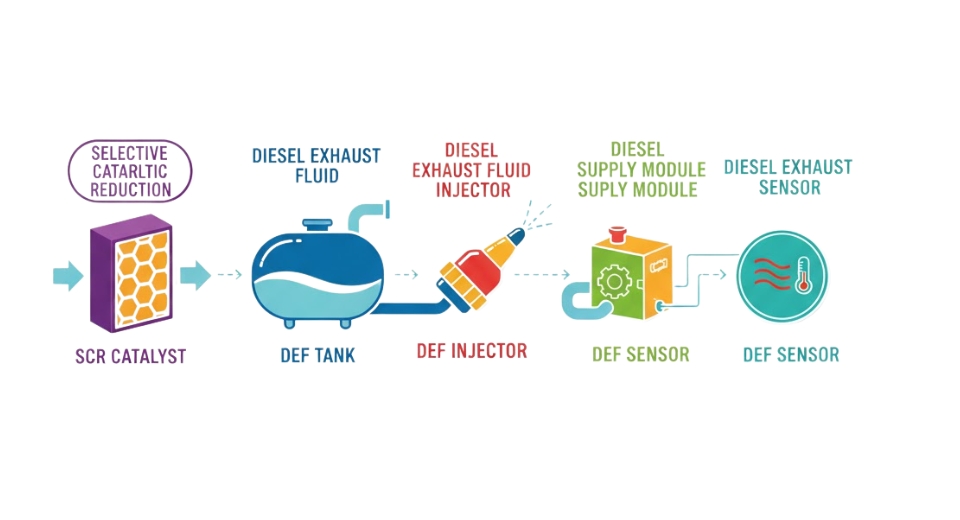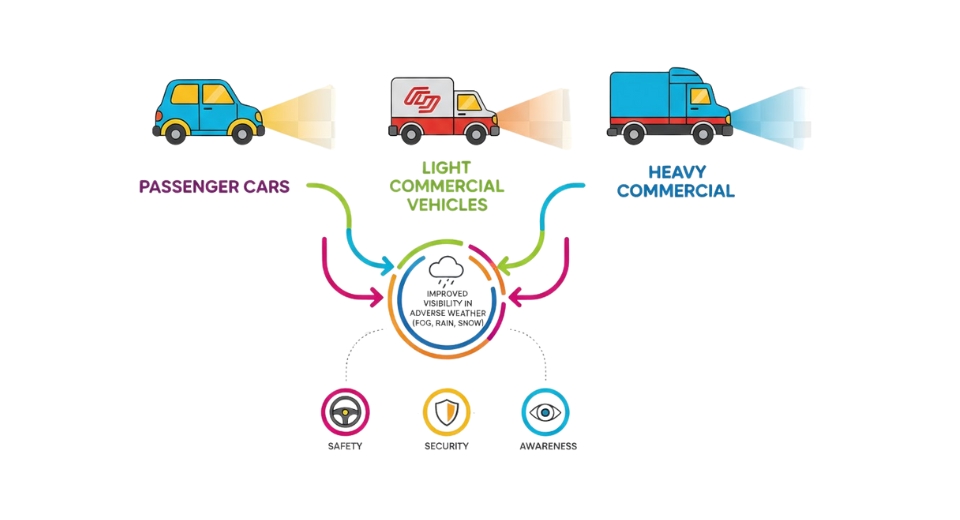MARKET OVERVIEW
The global automated parking system market is an important part of urban infrastructure and the transport sector, reflecting the growing needs from consumers worldwide concerning effective and space-saving forms of parking. As vehicle ownership increases and available parking places continue to be under pressure, automated systems will gain widespread acceptance in optimizing land use and improving parking operations. These systems integrate all possible advanced technologies integrated into their operation to be able to manage parking spaces more efficiently, thus reducing congestion and improving access to residential and commercial areas.
Demand for such solutions, which help to improve the efficiency of parking management by reducing human intervention, is the primary driver of the global automated parking system market. These systems combine mechanical and software-driven processes to transport and park vehicles within specific slots. Until then, automated parking systems can facilitate the usage of vertical and underground space in a structured manner as urban agglomerations continue to grow and available land becomes scarce. The continuous integration of technology into parking space is bound to shape this market, thus powering innovations in system design and operational mechanisms in years to come.
A parking management automation eliminates all the inefficiencies that most traditional systems exhibit, allowing the very accurate handling of vehicles with no very wide driving lanes. Among the systems included in the global automated parking system market is a variety of configurations ranging from fully automated robotic systems down to semiautomatic systems employing the assistance of a human for part of the operation. Automated parking would become a significant component of smart city schemes as cities and companies pursue sustainability efforts. It would allow a much more organized method for vehicle storage. Such systems would contribute to minimizing traffic congestion by simplifying entry and exit processes besides optimal space utilization.
All the necessary integrated software, sensors, and robotics work together to move vehicles toward the open areas with minimal involvement from drivers for the automated parking solutions. The global automated parking system market will continue evolving as artificial intelligence advances, with a continued focus on IoT-driven technology, increasing the efficiency of operations it provides. As digitization continues to deepen, such infrastructure will include real-time monitoring, automated ticketing, and predictive analytics to enhance user experience. In turn, data-driven insights will enable parking facility operators to harness improved security intelligence, space utilization, and optimized maintenance schedules.
Various industrial sectors will keep rolling out an automated parking system for improved convenience and safety. The global automated parking system market will evolve, where sustainable designs would become a prime focus, especially with energy-efficient components and eco-friendly building materials. Development will be pushed by an urge to curtail land usage while permitting a greater volume of vehicles on the parking floor.
As regulatory frameworks evolve, parking infrastructure will align with urban smart planning initiatives, thereby further broadening the global automated parking system market. Governments and urban planners will motivate automated solutions in favor of sustainable mobility strategies, reducing emissions from idling vehicles, and optimizing layouts of cities. Stringent regulations on space efficiency and environmental impacts would entice industries to adopt these systems to synchronize with current urban development procedures.
It is this same Global Automated Parking System that would be integrating added features such as contactless payment, enhanced security, and faster retrieval of vehicles. As cities are changing, the demand for automated parking solutions would become urgent in the orderly and effective management of parking. The future of this market will systematically evolve with advancing technologies that offer smarter, connected solutions and redefine traditional parking infrastructure.
Global automated parking system market is estimated to reach $85.66 Million by 2032; growing at a CAGR of 2.2% from 2025 to 2032.

GROWTH FACTORS
The ever-increasing interest for efficient parking solutions is steering the future of the global automated parking system market. As cities continue their growth trajectory, space-saving and time-efficient parking solutions will consistently be needed. Conventional parking systems consume valuable land area and contribute to congestion, therefore adopting automated systems seems most reasonable. The automated systems use contemporary technologies to enhance parking capacity maximally while rendering comfort for the driver. Development toward smart urban infrastructure will therefore stimulate the implementation of automated parking systems in similarity to other projects aimed at creating sustainable and well-managed city environments.
The rise in the number of vehicles in urban areas has been one of the prominent factors driving the market. With more people depending on personal transportation, an increasing degree of difficulty is being presented in finding any available parking lot. This problem manifests in automated parking systems, which use mechanical and software-based means to stack and retrieve vehicles in an efficient manner. This means besides saving space, it reduces the time taken to look for a parking lot, thus reducing traffic. With governments and town planners now more focused on sustainability, this aspect of investment in smart cities has gained momentum. These automated parking systems complement the work being done by reducing land use while also reducing carbon footprint while vehicles idle.
The enormous growth potential standing in front is, however, threatened with a number of challenges impeding traction. High installation and implementation costs remain a matter of concern for developers and city planners to date. Such systems require huge investment in technology and infrastructure, which makes the feasibility of their large-scale implementation difficult for some regions. Besides this limitation, regulatory restrictions and zoning laws can play a hindrance in some places by limiting the development of automated parking facilities. Overcoming these challenges should involve cooperation between the policymakers, technology providers, and investors to create feasible solutions for the industry to attain widespread adoption.
In the near future, technological advances will provide a successive chain of opportunities in the global automated parking system market. One promising development is the combo of automated parking with electric vehicle charging stations. The increasing shift of drivers toward electric vehicles will continue to add demand for reasonably convenient charging options. Cities could seamlessly incorporate the two systems together, providing drivers with a hassle-free experience that supports sustainable transport. This will not only promote efficiency but also maintain synergy with global efforts to minimize environmental degradation.
As a result of the continued push toward smart cities and sustainable solutions, the world of automated parking would play a major role in defining the future of urban mobility. The companies and government investments in these innovations will always stand a better chance of solving the challenges.
MARKET SEGMENTATION
By Automation Level
With increased congestion in urban areas, the need for efficient parking solutions will never cease growing. In cities housing more and more people within limited space, advanced technology enables parking systems to be integrated into the cities and industries to manage parking better. The global automated parking system market will be among the major contributors to this answer where solutions maximize space while reducing traffic and improving overall convenience. These systems are supposed to answer all the hassles caused by traditional parking systems through an automated process that makes parking easier, faster, safer, and more effective.
More advancement in automated parking systems will be seen as technology improves. Companies are innovating to maximize the use of artificial intelligence, sensors, and real-time tracking of data in promoting improved operational efficiency. Such innovations will provide the facility to park or release the vehicle with minimal human intervention, thus reducing errors and time consumption. Market shapes toward energy efficiency and sustainability will also be that automated parking facilities would be built with less power consumption and also flexibility to electric vehicles. Automated systems will develop keeping into account the increasing environmental concerns when the systems are being constructed to reduce fuel consumption by decreasing search time for parking spaces.
The global automated parking system market is organized in terms of levels of automation among semi-automated and fully automated systems. Semi-automated systems guide drivers up into fixed spaces and optimized the space available. Whereas all the responsibility is taken by fully automated systems and vehicles get parked without any intervention from the driver's end, demand for fully-automated solution will always rise when cities start investing in smarter infrastructure. Thus, the cars will be parked in little or no driving lanes well within the area, which will maximize use of land, especially in high-density regions where space is at premium.
In the near future, advancements will increase the convenience level for users when mobile applications and cloud-based platforms would allow drivers to pre-book parking lots in advance. Some of the new features for automated parking facilities will include security features like surveillance systems and controlled access to ensure that the safety of vehicles is guaranteed. These systems will be gradually adopted; businesses, residential complexes, and public spaces will employ them wishing to save on operation costs while optimizing parking.
Competition in the global automated parking system market will force companies into developing more efficient and reliable, and user-friendly solutions. Automated parking will be another model on which many smart cities will build their urban development, and parking will cease to be a challenge-an experience-say not a more intense experience. Modern technology makes these systems less expensive, thus making them a common feature of urban planning in contemporary cities.
By Design Model
Increasing the number of spaces in a city makes it even more necessary to think about having efficient parking, and the need will continue to increase. The global automated parking system market will expand rapidly with advancing technologies on top of it, most of them having better ways of managing vehicle storage. Automated parking systems maximize available spaces, reduce congestion, and add convenience for the drivers. As urbanization rises, these systems assume an integral role in revolutionizing the mode of parking management, making it more efficient and accessible.
Parking shall not just be about management of space quite obviously; it also improves safety, reduces emissions, but most of the time elevates user experience. It wastes time, fuel, and annoyance in drivers using traditional parking methods. They all have had driven challenges. Automated systems solve everything by reducing the very minimum efforts in parking and retrieval processes of a vehicle. With cities going high-tech in use, it will be interesting to see how smartly these new features like AI-enabled vehicle identification, real-time monitoring of data, and contactless payment would redefine this industry.
The global automated parking system market covers different types of design models such as hydraulic and electromechanical systems. Hydraulic models are known to have sufficient endurance and load capacity, making them well-suited for multi-storey structures. Electromechanical, on the other hand, is gaining popularity in precision and efficiency. It is expected that with the advancement in automation, these systems will be versatile and cater to all types of needs-whether residential, commercial, or public. The focus will definitely be in realizing further improvements in speed, energy efficiency, and maintenance processes that would enable long-term reliability.
Smart cities will depend on automated parking systems to reduce traffic congestion and improve land efficiency. In most cities, such solutions will integrate car charging stations, enabling electric vehicles to charge while parked. Robotics, IoT connectivity, and data analytics will enhance the performance of parking facilities, allowing them to respond clearly to user demands. As self-driving advances, automated parking systems will also evolve to fully embrace the hands-free parking experience, which will be completely integrated with the autonomous vehicle.
The competition within the global automated parking system market is forcing companies to innovate and improve their products. Value will be added by developers to make their systems affordable, space-efficient, and user-friendly. Automated parking solutions will become entirely indispensable as cities continue building: the future model for parking vehicles will change absolutely.
By Platform Type
The growing demand for efficient urban parking will catapult advancements in the global automated parking system market. With increasing insatiability and space constraints, old school methods of parking are failing. The more intelligent system of automated parking will cut congestion and maximize space usage. These systems will, therefore, definitely save time and enhance safety by minimizing human intervention. Improvements in technology will shape more sophisticated parking systems with AI and automation for user's comfort.
Companies will set their design sights along the lines of systems entertained by different realities in the urban landscape, including both the palleted and non-palleted platforms of the future of parking. Palleted systems will still dominate because they provide an orderly way to safely store vehicles, placing them on platforms that move automatically. This configuration will always remain the best for associated zones needing utmost precision in organization and controlled movement. Non-palleted systems, on the other hand, will attract more interest as they park and retrieve vehicles without being restricted to a fixed platform. These systems will leverage advanced sensors and robotics for quick and efficient car placing, thus giving a lot of flexibility in space management.
The global automated parking system market will be fiercely competitive, with companies eager to develop faster and smarter solutions. Parking buildings in the future will come loaded with seamless digital interfaces for users to pre-book spaces and check the availability status in real time. With smart connectivity, automated systems will be able to communicate with vehicles, ensuring a seamless parking environment. An automated parking system will develop into an institutional structure with the association of electric and autonomous vehicles going mainstream. In this case, the parking process will automatically incorporate charging stations for electric vehicle owners who will be able to charge their vehicles when parked.
Along with the safety and security features, design will ensure that such systems mitigate the risks of damage and theft. Automated solutions will virtually eliminate human errors that usually result in accidents and damages in regular parking lots. With a formidable security advantage provided by AI monitoring technology and cameras, such vehicles will be under constant safeguard. The need for sustainable solutions will also shape the industry, allowing energy-efficiency design and eco-friendly construction to be the norm.
With the urban sprawl, the need for smart parking solutions will only increase. The global automated parking system market will thereby be characterized by efficient solutions, smart tech, and versatility to ensure that every parking difficulty in the future is answered through ingenious systems that enhance comfort and sustainable development.
By End User
Cities grow out and handle more and more vehicle ownership; at some point these advantages in future will demand a better and better supply in intelligent parking, which in turn will spearhead for creating for our cities in the emerging future. The share of the global automated parking system market will play an important role in combating these conditions through technology solutions maximizing areas and minimizing traffic congestion. Now automated systems feature improvements in the efficiency of parking operations, security, and convenience for users.
The advent of new technologies will take the push forward for the evolution of these systems. Integrated circuits, real-time monitoring, and diagnostic feature artificial intelligence will make automated parking much more efficient. While a way to improve ranking of cities as green cities is expected to be developed, limited idling time for a vehicle is also expected to reduce emissions. When wide driving lanes and slopes required in parking structures are eliminated, the space becomes optimally utilized.
The global automated parking system market will be opened to many growth opportunities in every sector. Commercial companies such as shopping malls, office towers, et al, will require the adoption of automated solutions to facility high-density vehicle loading efficiently. Besides the improvement in better security, the increased amenity will boost parking convenience for visitors. In modern developments of residential complexes, mechanized parking will become a prerogative service, given that by urbanization, residential units shall be smaller in size. These systems will complement the existing availability of space, while at the same time securing the vehicles. Mixed development shall also include automated parking, which will be the combination of housing, business, and recreational areas. These developments require parking which saves the most space and provides flexibility for different users.
The industry will be compelled to push for competition that will result in the development of advanced solutions. The main discussion will be cost-effective operations and more efficiency brought about by having smart technology in the parking system of the future. For instance, the incorporation of machine learning in the systems will learn and predict how parking takes place and how parking places will be allocated. The use of robotics will ensure even more accuracy in parking and retrieval of vehicles. This will go up with the modernization process in urban areas, during which the government and private developers will invest more on automated parking for smarter and easier accessibility to cities.
In the next future, the global automated parking system market is expected to change the way we think about parking. More and more sustainable technologies will be implemented considering the many advantages of the new technology adoption-promoting future development urban planning. They will thereby create a future where businesses, residential complexes, and mixed developments come together under a common brand - that of efficiency and convenience.
|
Forecast Period |
2025-2032 |
|
Market Size in 2025 |
$74.14 million |
|
Market Size by 2032 |
$85.66Million |
|
Growth Rate from 2025 to 2032 |
2.2% |
|
Base Year |
2024 |
|
Regions Covered |
North America, Europe, Asia-Pacific, South America, Middle East & Africa |
REGIONAL ANALYSIS
The demand for automated parking systems is expected to rise with growing congestion in urban areas and the growing need for efficient solutions for parking. These systems are becoming more reliable with the advancements in technology, thereby reducing human intervention in parking and increasing the maximization of the available space. The global automated parking system market will continue to expand as cities, industries, and residential complexes consider smarter ways to manage parking. Artificial intelligence, sensors, and data analytics play a very important role in the future of parking by making it accessible, fast, and environmentally friendly.
The adaptation of this technology varies from one region to another depending on their population density, urban planning, and government initiatives. Steady growth of North America is expected, focusing on smart city projects and modernization of their infrastructure. Automated solutions are being implemented in the United States, Canada, and Mexico to combat parking shortages in major urban areas. Heightened implementation of these systems by businesses and city planners is expected owing to the concerns regarding traffic congestion.
The countries in Europe, namely UK, Germany, France, and Italy, are implementing the automated systems for parking due to space constraints caused by densely populated cities. Strict regulations on emissions and environmental concerns are also acting as an advantage for the implementation of these systems since they minimize idle time for looking for parking. This push for sustainable urban development will spur more innovations in automated parking in this region.
Asia-Pacific is going to see a good growth curve with the lead taken by India, China, Japan, and South Korea. Rapid urbanization and increasing vehicle ownership lead to existing parking spaces being under tremendous pressure, making automation a very viable solution. Government policies promoting smart infrastructure and technological advancements will play a pivotal role in the growth of this market in this region. The digital payment system and real-time monitoring of the parking area would add to the efficiency.
In South America, especially Brazil and Argentina, much of the potential benefits of automated parking are slowly gaining recognition. These modern parking solutions could assist in space management as urban centers grow. In comparison with other regions, the rate of adoption may lag, however, the increasing stock of high-rise buildings and commercial hubs will create an opportunity for the automated parking system to advance with traction.
Middle East & Africa are focused on modernizing urban infrastructure, largely in GCC countries, Egypt, and South Africa. High vehicle density in metropolitan areas is pushing developers to consider automated solutions. The luxury developments and smart city projects in the region will drive demand, ensuring that parking will no longer be a challenge but will become a seamless experience.

COMPETITIVE PLAYERS
The requirement for parking options will increase with the cities becoming crowded. As space becomes limited and the number of vehicles increases, cities and businesses want to manage parking in smart ways instead. The global automated parking system market will play an important role by coming up with such solutions that optimize spatial availability, decongestions, and improve the overall user convenience. These systems are technologically driven-their operation includes robotics and artificial intelligence to park and retrieve vehicles while involving a minimal amount of human effort.
It is on automation, therefore, that the very nature of the parking facility will change. While an ordinary parking structure occupies a considerable land area, automated parking buildings are designed to organize the parking of cars compactly, arranging the vehicles vertically. This way, parking space would be optimally occupied, thereby ensuring that emissions are reduced since drivers would no longer have to cruise around looking for a parking spot. Concerns about the environment and eco-efficiency would propel governments and firms toward a more substantial financing share-in these systems acting as success factors for sustainable development.
The competitors in the global automated parking system market would focus on developing faster, safer, and reliable parking solutions. Companies like AutoMotion Parking Systems, Bosch, and Wohr Parking Systems Pvt. Ltd. carry the reputation already in the field as innovators in that area. As the technologies are improving, more enterprises will include smart sensors, machine learning, and real-time data analysis to better efficiency in systems. Companies like Continental, Dayang Parking Company Ltd, and DENSO Corporation are investing in such innovations to improve the automation accuracy and decrease the cost of operation.
Such future provisions may also incorporate mobile app connectivity giving users the ability to book their slots and obtain real-time updates. Their solutions provide digital connected seamless experience for end-users. Eito and Global, Fata Automation, and Klaus Multiparking are working on these types of solutions. Along with these developments, there are firms exploring automated parking systems that would incorporate charging stations for electric vehicles like Lödige Industries, McParking Systems Inc., and Park Plus, Inc., thereby catering to electric car adoption on the rise.
Innovation is bound to spur competition. The likes of Parkmatic, Parkopedia Ltd., and Robotics Parking System Inc. will also work toward a different horizon of innovation in more flexible, cost-effective solutions. Improvements in security and speed will be expected considering that ShinMaywa Industries, Ltd., SKIDATA AG, and Skyline Parking are working on several projects on automated parking. Meanwhile, it is very likely that Utron Parking, Valeo, and Westfalia Parking will also focus their projects on new, AI-powered monitoring systems that could enhance safety and minimize system errors.
As urban development progresses, so too ought to automated parking as an important component of modern infrastructure. Those companies that will lead in identifying innovations and the expectation of convenience to users will.
Automated Parking System Market Key Segments:
By Automation Level
- Semi-Automated
- Fully-Automated
By Design Model
- Hydraulic
- Electro-Mechanical
By Platform Type
- Palleted
- Non-palleted
By End User
- Commercial
- Residential
- Mixed-use
Key Global Automated Parking System Industry Players
- AutoMotion Parking Systems
- Bosch
- Wohr Parking Systems Pvt. Ltd.
- Continental
- Dayang Parking Company Ltd
- DENSO Corporation
- Eito and Global
- Fata Automation
- Klaus Multiparking
- Lödige Industries
- McParking Systems Inc.
- Park Plus, Inc.
- Parkmatic
- Parkopedia Ltd.
- Robotics Parking System Inc.
WHAT REPORT PROVIDES
- Full in-depth analysis of the parent Industry
- Important changes in market and its dynamics
- Segmentation details of the market
- Former, on-going, and projected market analysis in terms of volume and value
- Assessment of niche industry developments
- Market share analysis
- Key strategies of major players
- Emerging segments and regional growth potential











 US: +1 3023308252
US: +1 3023308252






